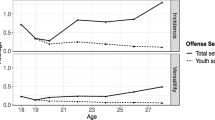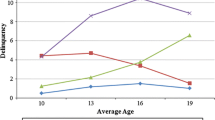Abstract
Traditional theories of delinquency causation generally fail to consider delinquency in the context of norms and age-role transitions peculiar to adolescence. Hence, in this study, an age-based theory of delinquency causation is developed, which assumes the importance of norms and roles specific to adolescence. This theory draws upon the assumption that socialization is recurrent, in contrast to the premises regarding socialization which underlie traditional theories of adolescent deviance. The recurrent model of socialization and that assumed by traditional theorists are discussed, and their implications for the causes of delinquent behavior are examined. Some effort is made to show that the recurrent model of socialization suggests an anomie of age as the basis for delinquent acts. It is suggested that this age-based anomie stems from conditions of normlessness associated with certain role transitions in adolescence and the pacing of these transitions. Further, it is suggested that certain groups are especially prone to an anomic age transition. The role transitions most likely to be subject to such anomic conditions and the adolescent subgroups most prone to experience anomie as a result of the pacing of their age-role transitions are identified.
Similar content being viewed by others
References
Bacon, M., and Jones, M. (1968).Teenage Drinking, Crowell, New York.
Benedict, R. (1938). Continuities and discontinuities in cultural conditioning.Psychiatry 1(May): 161–167.
Cahalan, D., Cisin, I., and Crossley, H. (1969).American Drinking Practices, College and University Press, New Haven, Conn.
Cahalan, D., and Room, R. (1974).Problem Drinking Among American Men, Rutgers Center of Alcohol Studies, New Brunswick, N.J.
Carey, J., and Mandel, J. (1968). A San Francisco Bay area speed scene.J. Hlth. Soc. Behav. 9: 164–174.
Clausen, J. (1968). Perspectives on childhood socialization. In Clausen, J.Socialization and Society, Little Brown, Boston, pp. 130–181.
Clinard, M. (1964).Anomie and Deviant Behavior, Free Press, New York.
Cloward, R., and Ohlin, L. (1960).Delinquency and Opportunity, Free Press, New York.
Cohen, A. (1955).Delinquent Boys, Free Press, Glencoe, Ill.
Csikszentmihalyi, M., and Larson, R. (1978). Intrinsic rewards in school crime.Crime Delinquen. 24(July): 322–335.
Davis, F., and Munoz, L. (1968). Heads and freaks: Patterns and meanings of drug use among hippies.J. Hlth. Soc. Behav. 9: 156–163.
Dickinson, G. (1978). Adolescent sex information sources: 1964–1974.Adolescence 13(Winter): 653–658.
Eisenstadt, S. N. (1956).From generation to generation: Age groups and social structure, Free Press, Glencoe, Ill.
Erickson, M., and Empey, L. (1963). Court records, undetected delinquency and decision-making.J. Crim. Law, Criminol. Police Sci. 54: 456–467.
Foner, A., and Kertzer, D. (1978). Transitions over the life course: Lessons from age-set societies.Am. J. Sociol. 83: 1081–1104.
Gordon, C. (1976). Development of evaluated role identities. In Inkeles, A., Coleman, J., and Smelser, N. (eds.),Annual Review of Sociology, Vol. 2, Annual Reviews, Palo Alto, Calif., pp. 405–433.
Hindelang, M., Hirschi, T., and Weis, J. (1979). Correlates of delinquency: The illusion of discrepancy between self-report and official measures.Am. Sociol. Rev. 44: 995–1014.
Hornick, J. P. (1978). Premarital sexual attitudes and behavior.Sociol. Quart. 19(Autumn): 534–544.
Kandel, D., Kessler, R., and Marguiles, R. (1978). Antecedents of adolescent initiation into stages of drug use: A developmental analysis.J. Youth Adoles. 7: 13–40.
Kanin, E. J. (1967). Reference groups and sex conduct norm violations.Sociol. Quart. 8: 495–504.
Kohlberg, L., and Gilligan, C. (1971). The adolescent as philosopher: The discovery of the self in a postconventional world.Daedulus 100: 1051–1086.
Kornhauser, R. R. (1978).Social Sources of Delinquency: An Appraisal of Analytic Models, University of Chicago Press, Chicago.
Lerman, P. (1968). Individual values, peer values and subcultural delinquency.Am. Sociol. Rev. 33: 219–235.
Maccoby, E. (1968). The development of moral values and behavior in childhood. In Clausen, J. (ed.),Socialization and Society, Little, Brown, Boston.
Matza, D. (1964).Delinquency and Drift, Wiley, New York.
Matza, D., and Sykes, G. (1961). Juvenile delinquency and subterrranean values.Am. Sociol. Rev. 26: 713–719.
Merton, R. K. (1957).Social Theory and Social Structure, rev. ed., Free Press, Glencoe, Ill.
Neugarten, B., and Peterson, W. A. (1957). A study of the American age grade system.Proceedings 4th Congress Int. Assoc. Gerontol. 3: 497–502.
Ryder, N. (1965). The cohort as a concept in the study of social change.Am. Sociol. Rev. 30: 843–861.
Sapir, E. (1958).Culture, Language and Personality, University of California Press, Berkeley, Calif.
Sexton, P. C. (1969).The Feminized Male: Classroom, White Collars and the Decline of Manliness, Vintage Books, New York.
Short, J., and Nye, I. (1958). Extent of unrecorded delinquency: Tentative conclusions.J. Crim. Law Criminol. Police Sci. 49: 296–302.
Simon, W., and Gagnon, J. (1976). The anomie of affluence.Am. J. Sociol. 82: 356–378.
Smart, R., and Fejer, D. (1972). Drug use among adolescents and their parents: Closing the generation gap in mood modification.J. Abnorm. Psychol. 79: 153–160.
Teevan, J. J. (1972). Reference groups and premarital sexual behavior.J. Marr. Fam. 34(May): 283–291.
Werthman, C. (1976). The functions of social definitions in the development of the gang boy's career. In Giallombardo, R. (ed.),Juvenile Delinquency, Wiley, New York, pp. 327–347.
Wise, N. B. (1976). Juvenile delinquency among middle class girls. In Vaz, E. (ed.),Middle-Class Juvenile Delinquency, Harper & Row, New York, pp. 179–188.
Author information
Authors and Affiliations
Additional information
Received her Ph.D. from the University of Chicago in 1979. Major interests are deviant behavior, drugs, juvenile delinquency.
Rights and permissions
About this article
Cite this article
Covington, J. Adolescent deviation and age. J Youth Adolescence 11, 329–344 (1982). https://doi.org/10.1007/BF01537174
Received:
Issue Date:
DOI: https://doi.org/10.1007/BF01537174




